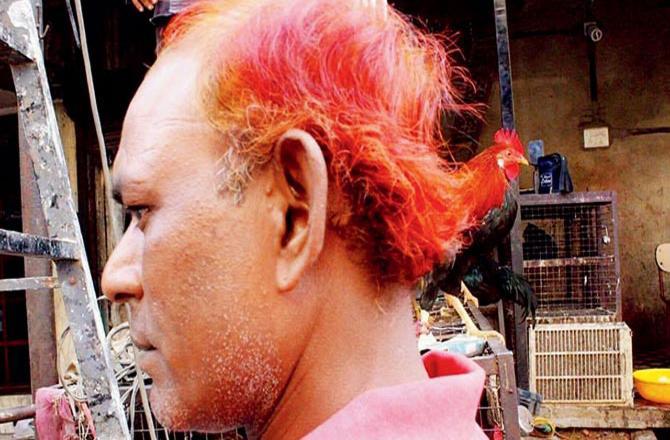Photographers are using elements of comparison and contrast to create juxtapositions, which will leave you with a chuckle. How do they do it?

This photograph was taken at a busy market near Jama Masjid in Ahmedabad. The man's auburn colour hair blends in with the hen's plumage in the background
The prime and often cringe-worthy examples of juxtapositions that we've come across are those by tourists "holding up" the sun or the moon. But, street photographers across the world are using the composition trick to not just catch your attention, but also tell stories. The term refers to a side-by-side placement of elements in order to either compare or contrast them, or to show similarities. Photographers often employ the technique to insert an element of surprise, or humour. People are not stationary and, therefore, it's not an easy concept to master. Three visual storytellers, who have managed to ace it, tell us what it takes to be at the right place, and at the right time.
ADVERTISEMENT
'You have to anticipate the moment'
Yash Sheth, a 26-year-old electronics engineer from Mumbai, picked up the skill by browsing through the work of photographers from Magnum—an international photography cooperative founded in Paris in 1947—to understand their method and approach. "For me, street photography is all about patience and curiosity. But, I am not an instinctive photographer. So, I consciously observe small things around me, wherever I go. One must also learn to anticipate the moment. The image is made in my mind before the camera." Sheth says it helps to keep a low-profile when shooting on streets, and his failed images have only helped improve and sharpen his sense of timing. He is also part of Bambai Collective on Instagram, which comprises street and documentary photographers.
Yash Sheth
Follow: @yashsheth3, Instagram
'When the moment is pregnant, you should be there to deliver'
Shot by Vohra in New Delhi, this photo shows a dog with a rather, extended tail
Vineet Vohra, an internationally celebrated street photographer from New Delhi, started his journey as a wildlife photographer, but the "impermanence and the sheer excitement of the unknown" drew him towards street photography. "I get intrigued by things that everyone seems to miss. That said, it is also very demanding. One can't have a fixed formula or tools to make an image." For him, it's a marriage between the photographer and the moment. "And, when the moment is pregnant, the photographer should be there to deliver." Vohra shoots for at least two hours daily. "So, it's just like riyaaz. I want to create a dialogue or a language, which I'm most comfortable with and I want people to have subjective interpretations. My images should be able to raise questions and give subtle hints to the answers present in the image itself."
Shot in Pushkar, the image shows a real camel juxtaposed with a fake one
Follow: @vineet_vohra, Instagram
Vineet Vohra
'It's about being fully present'
A picture of a man breaking into a little jig. "It was mid-autumn and sunset light was at low angle and streaming through a narrow gap on the opposite side of an escalator. When people passed by, their shadow would then project onto the transparent glass," says Wong
Edas Wong, a Hong Kong-based photographer, has been creating ripples with his impressive illusions. The images range from a man with an afro, thanks to the positioning of a tree in the background, to a man appearing to be kicked in the backside by a running advert. Wong says he gravitated towards street photography while working as a radio access expert in Sweden. "I was working in the R&D department to develop a mobile network, and that job required serious logical thinking. It left me exhausted." Street photography offered him the chance to "just feel". Wong goes out on the street with a clear mind in order to observe the "connections" between objects. "By doing this, I bring myself back to the 'now' and escape from all problems at work, life, and the political situation in the country. It's about being fully present." Not all of his photos are funny, though. "I just follow my feelings to shoot. You can tell if I'm happy or sad, or lonely in that moment, by simply looking at my pictures."
This photograph shows a man with "horns". "I found this poster, when I stepped out a shopping mall. The glasses actually looked like horns and I decided to wait for the magic moment," Wong, a Hong Kong-based photographer shares
Follow: @edaswong, Instagram
Edas Wong
 Subscribe today by clicking the link and stay updated with the latest news!" Click here!
Subscribe today by clicking the link and stay updated with the latest news!" Click here!






